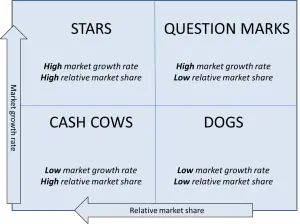Contents
Overview of the BCG Matrix
The BCG Matrix is a portfolio model developed by the Boston Consulting Group (BCG) in 1968. It has been popularized over time through inclusion in many strategy and marketing textbooks.
One of its prime appeals is that it communicates an important element of strategy – that is, the role of competitive strengths and market opportunity – through a very straightforward and simple to understand matrix.
It tends to have a high level of recall among students and practitioners because the four matrix boxes have unusual names – namely cash cows, stars, question marks and dogs – making it one of the more memorable marketing and strategy models available.
General purpose of the BCG Matrix
The BCG matrix was originally developed to assist companies that have multiple product portfolios (or strategic business units) to help guide their decisions on reinvestment. In other words, it was a model designed for use in large conglomerate organizations that operated many different divisions.
For example, a large retailer may have chains of supermarkets, department stores, convenience stores, specialty stores and so on. These all represent different business portfolios – sometimes referred to as strategic business units – for the organization. Because it helps analyze and guide business portfolios, it is considered to be a portfolio model.
The BCG matrix was a simple way of plotting the firm’s different business portfolios onto the same matrix and providing some guidance to how the company’s resources should be allocated across the different business units.
The two dimensions of the BCG matrix
The BCG matrix considers two elements to form its four quadrants. These two dimensions are:
- Growth rate of the market
- Relative market share
The growth rate of the market dimension is used as a proxy measure of the attractiveness of the market, with high-growth markets being seen as more attractive and offering more potential and opportunity.
Relative market share is used as a surrogate of competitive strength. The larger the firm’s market share, relative to its largest competitor, the stronger the firm is in the marketplace.
Therefore, the BCG matrix combines a measure of market attractiveness against overall competitive strengths in order to identify the quadrant of the model with the firm or business unit is situated.
The four quadrants of the BCG matrix
- Businesses in high growth markets, with a high relative market share are considered to be “stars”.
- Those businesses operating in low growth markets, but also with a high relative market share are considered to be “cash cows”.
- If the business is in a high-growth market, but has a low relative market share, the net business is classified as a “question mark”.
- The final quadrant is for businesses in low growth markets, where they had a relatively low market share – and these businesses are classified as “dogs” in the BCG matrix.
General introduction only
Please note that this section just provides a brief overview of the BCG matrix, please use the above links or menu to further information on the model.
Also note that there is a free template available for download to produce the BCG matrix.
Below is an independent video, which is a good introduction to the BCG Matrix concept.

